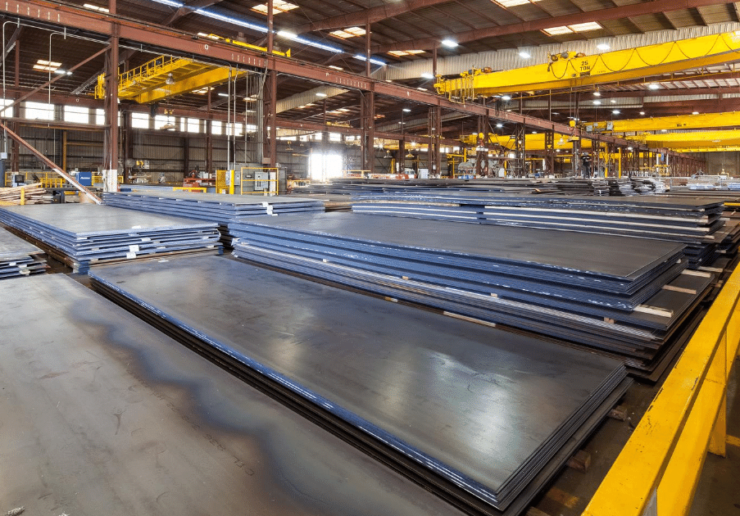Kloeckner Metals is proud to supply HSLA steel plate to exact customer specification across its nationwide branches.


| Grades | Thickness | |||
|---|---|---|---|---|
| Width | Length | |||
| A36 | 3/16" - 8" | 48" - 120" | 96" - 480" | |
| A572 Grade 42 | 50 | 60 | 65 | 3/16" - 6" | 48" - 120" | 96" - 480" | |
| A588 | 3/16" - 4" | 48" - 120" | 96" - 480" | |
| A871-65 | 3/16" - 1-1/4" | 48" - 120" | 96" - 650" | |
| A709 Grade 36 | 50 | 50W | 3/16" - 4" | 48" - 120" | 96" - 480" | |
| A656 Grade 50 | 60 | 70 | 80 | 3/16" - 1" | 48" - 120" | 96" - 480" | |
| 1045 | Inquire for sizes | |||
A36 is a low carbon steel and is used in many different industries for different applications. A36 is made in a similar way to most carbon steels and its final dimensions are formed by hot rolling. The most common application is steel plate that is used in the construction, automotive, and heavy equipment industries. Kloeckner Metals supplies A36 steel throughout North America.
Already a customer? Shop A36 on Kloeckner Direct.
A572 is a HSLA steel plate that Kloeckner offers in grades 42, 50, 60, and 65. The most commonly used grade is the A572-50 – it is considered a “workhorse” grade and shows up in structural applications, heavy construction equipment, building structures, and more. A572 steel is alloyed with small amounts of both Columbium and Vanadium. This specific steel is known for its high strength and corrosion resistance.
Already a customer? Shop A572 on Kloeckner Direct.
A588 is a high-strength, low-alloy steel plate. It is known for its corrosion-resistant and is offered in 3 different grades including, A, B, and K. Due to A588’s high corrosion resistance, it is often used in high impact applications with high vulnerability to corrosion. A588 steel is also known as weathering steel. Some common applications are in bridges and buildings in the construction industry.
Already a customer? Shop A588 on Kloeckner Direct.
A871-65 is a high-strength, low alloy structural steel with good corrosion resistance. Due to its corrosion resistance, as well as its light weight, it is often used in high-impact applications, including lighting poles, transmission, and signposts. If A871-65 is designed the right way, it can be used without being painted. Some unpainted applications include pedestrian bridges, railings, and gabion walls.
Already a customer? Shop A871-65 on Kloeckner Direct.
A709 is mainly used in the manufacturing of bridges. Because bridges are exposed to the elements, these grades are often specified according to Charpy impact tests specific to the different climatic regions where the bridge will be constructed.
A656 steel plate can be found in a range of end-uses including construction equipment, general fabrication, crane booms, truck frames, and more. A656 is considered both a HSLA and structural steel. A656 steels have superior formability and are usually supplied as-rolled.
Already a customer? Shop A656 on Kloeckner Direct.
A830 steel plate is medium-carbon, structural steel that’s used in gear production, mining equipment, and processing industry applications. A830 is produced with a chemical composition of .43-.50 carbon and .60-.90 manganese. 1045 grade steel is included in the ASTM A830 family of specifications. It has high strength and hardness properties and can be heat treated.
Already a customer? Shop A830-1045 on Kloeckner Direct.
Kloeckner Metals supplies 33 Max in an as-rolled condition. 33 Max is steel with up to .33 max carbon and is used in physical applications without specifications for physical or mechanical properties.
Already a customer? Shop 33 Max on Kloeckner Direct.
A36 is a low carbon steel and is used in many different industries for different applications. A36 is made in a similar way to most carbon steels and its final dimensions are formed by hot rolling. The most common application is steel plate that is used in the construction, automotive, and heavy equipment industries. Kloeckner Metals supplies A36 steel throughout North America.
Already a customer? Shop A36 on Kloeckner Direct.
A572 is a HSLA steel plate that Kloeckner offers in grades 42, 50, 60, and 65. The most commonly used grade is the A572-50 – it is considered a “workhorse” grade and shows up in structural applications, heavy construction equipment, building structures, and more. A572 steel is alloyed with small amounts of both Columbium and Vanadium. This specific steel is known for its high strength and corrosion resistance.
Already a customer? Shop A572 on Kloeckner Direct.
A588 is a high-strength, low-alloy steel plate. It is known for its corrosion-resistant and is offered in 3 different grades including, A, B, and K. Due to A588’s high corrosion resistance, it is often used in high impact applications with high vulnerability to corrosion. A588 steel is also known as weathering steel. Some common applications are in bridges and buildings in the construction industry.
Already a customer? Shop A588 on Kloeckner Direct.
A871-65 is a high-strength, low alloy structural steel with good corrosion resistance. Due to its corrosion resistance, as well as its light weight, it is often used in high-impact applications, including lighting poles, transmission, and signposts. If A871-65 is designed the right way, it can be used without being painted. Some unpainted applications include pedestrian bridges, railings, and gabion walls.
Already a customer? Shop A871-65 on Kloeckner Direct.
A709 is mainly used in the manufacturing of bridges. Because bridges are exposed to the elements, these grades are often specified according to Charpy impact tests specific to the different climatic regions where the bridge will be constructed.
A656 steel plate can be found in a range of end-uses including construction equipment, general fabrication, crane booms, truck frames, and more. A656 is considered both a HSLA and structural steel. A656 steels have superior formability and are usually supplied as-rolled.
Already a customer? Shop A656 on Kloeckner Direct.
A830 steel plate is medium-carbon, structural steel that’s used in gear production, mining equipment, and processing industry applications. A830 is produced with a chemical composition of .43-.50 carbon and .60-.90 manganese. 1045 grade steel is included in the ASTM A830 family of specifications. It has high strength and hardness properties and can be heat treated.
Already a customer? Shop A830-1045 on Kloeckner Direct.
Kloeckner Metals supplies 33 Max in an as-rolled condition. 33 Max is steel with up to .33 max carbon and is used in physical applications without specifications for physical or mechanical properties.
Already a customer? Shop 33 Max on Kloeckner Direct.
High-strength low-alloy steel is a type of alloy steel that’s chosen over carbon steel for its better mechanical properties or greater resistance to corrosion. Unlike other steels, it is not made to chemical composition specification, but to mechanical property specification. To maintain weldability and formability, the carbon content is kept to 0.05 to 0.25%; to add strength, copper, titanium, vanadium, and niobium may be added. Because high strength low alloy steels have high strength and toughness, they require 25-30% more power to form than carbon steels.
ANSWER:
You will find high strength low alloy steel plate in structures that need to handle high levels of stress and would benefit from a good ratio of strength to weight, for example bridges, cranes, trucks, cars, and roller coasters. Cross-sections made with it are usually 20% to 30% lighter than the equivalent made with carbon steel without sacrificing strength.
ANSWER:
High-strength steels (HSS) are categorized as 300 MPa tensile strength and above. These types of products have much higher strengths than mild steel and can help reduce thickness and part weight in comparison to mild steel parts.
ANSWER:
The strongest high strength low alloy steel plate is 980X. Available in sheet, strip, and plates up to 0.375 in., it has a yield strength minimum of 80,000 (552 MPa) and an ultimate tensile strength minimum of 95,000 (655 MPa). What it has in strength, it gives up in weldability, formability, and toughness, and has the worst rankings of high strength low alloy steels in all three categories.
ANSWER:
Repair of high strength low alloy steel plate is not recommended, whether you’re considering heat treatment or stitch welding. It should only be replaced at factory joints. Even sectioning or partial replacement is not recommended. Squeeze Resistance Spot Welding, MIG plug welding, or MIG Brazing can be used to replace factory spot welds.
ANSWER:
Because high strength low alloy steel plates lack pearlite—the thin layers of almost pure iron ferrite and cementite—they are more rust-resistant than most carbon steels.
ANSWER:
There are many different types of HSLA steel plate:
ANSWER:
Because high strength steels have unique properties, there are more challenges to welding them than mild steels. The process of welding can introduce strength to the weld joint because the weld metal has a tendency to shrink as it goes from liquid to solid.
Challenges to welding high strength steel include hydrogen embrittlement, risk of distortion, quenched and tempered steels, and choosing the right filler metal. Reducing the stress of welding means paying extra attention to proper weld joint design, filler metal selection, and heat input.
ANSWER:
You will find high strength low alloy steel plate in structures that need to handle high levels of stress and would benefit from a good ratio of strength to weight, for example bridges, cranes, trucks, cars, and roller coasters. Cross-sections made with it are usually 20% to 30% lighter than the equivalent made with carbon steel without sacrificing strength.
ANSWER:
High-strength steels (HSS) are categorized as 300 MPa tensile strength and above. These types of products have much higher strengths than mild steel and can help reduce thickness and part weight in comparison to mild steel parts.
ANSWER:
The strongest high strength low alloy steel plate is 980X. Available in sheet, strip, and plates up to 0.375 in., it has a yield strength minimum of 80,000 (552 MPa) and an ultimate tensile strength minimum of 95,000 (655 MPa). What it has in strength, it gives up in weldability, formability, and toughness, and has the worst rankings of high strength low alloy steels in all three categories.
ANSWER:
Repair of high strength low alloy steel plate is not recommended, whether you’re considering heat treatment or stitch welding. It should only be replaced at factory joints. Even sectioning or partial replacement is not recommended. Squeeze Resistance Spot Welding, MIG plug welding, or MIG Brazing can be used to replace factory spot welds.
ANSWER:
Because high strength low alloy steel plates lack pearlite—the thin layers of almost pure iron ferrite and cementite—they are more rust-resistant than most carbon steels.
ANSWER:
There are many different types of HSLA steel plate:
ANSWER:
Because high strength steels have unique properties, there are more challenges to welding them than mild steels. The process of welding can introduce strength to the weld joint because the weld metal has a tendency to shrink as it goes from liquid to solid.
Challenges to welding high strength steel include hydrogen embrittlement, risk of distortion, quenched and tempered steels, and choosing the right filler metal. Reducing the stress of welding means paying extra attention to proper weld joint design, filler metal selection, and heat input.
Between our global footprint, international transportation network,...
Steel base plates are fundamental elements employed in various manufacturing processes. These flat, rectangular...
Metal fabrication is a critical process that transforms raw metal materials into finished products....
The solar industry has undergone a significant transformation by incorporating steel products into various...
The unprecedented pace of solar growth is challenging and reforming America’s construction and engineering...
If you’ve got a roof over your head, it’s partly thanks to purlins. A...
Acquiring highly profitable company with annual sales of around USD 30 million Significant expansion...
A stainless steel depot is a specialized facility or supplier that stocks and provides...
American manufacturers use about 28.2 billion pounds of aluminum every year, 41.6% of it...
Leading steel distributor expands commitment to sustainability in the North American market. Kloeckner Metals,...
At Kloeckner, we are excited to announce that our Santa Fe Springs, CA location...

X
The Kloeckner Metals website uses modern technologies. Unfortunately, your browser doesn't support those technologies.
Download the latest version of one of these browsers to experience the site: